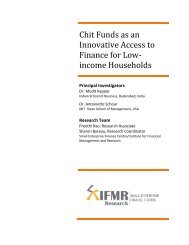Government of India Volume I: Analysis and Recommendations
Government of India Volume I: Analysis and Recommendations
Government of India Volume I: Analysis and Recommendations
Create successful ePaper yourself
Turn your PDF publications into a flip-book with our unique Google optimized e-Paper software.
CAPITAL CONTROLS<br />
requirements are fulfilled, there should be full national treatment <strong>of</strong> foreign entities, i.e.<br />
full symmetry when compared with resident entities. For instance, net worth, capital adequacy<br />
norms or investment restrictions should not be different for a foreign entity when<br />
compared to a resident entity performing similar functions or investments in <strong>India</strong>.<br />
8.2. Current framework<br />
The Foreign Exchange Management Act, 1999, codifies the existing approach to capital<br />
controls. It differentiates between current account transactions <strong>and</strong> capital account<br />
transactions. The Central <strong>Government</strong> makes rules in consultation with RBI for current<br />
account transactions, <strong>and</strong> the RBI in consultation with the Central <strong>Government</strong> makes<br />
regulations in relation to capital account transactions. This approach has led to a complex<br />
web <strong>of</strong> rules <strong>and</strong> regulations on capital controls spread across laws. It has also led to<br />
the absence <strong>of</strong> a clear <strong>and</strong> consistent framework <strong>of</strong> policy <strong>and</strong> translation <strong>of</strong> policy into<br />
law. In studying the current framework, the Commission notes that the deficiencies can<br />
be broadly be classified into two categories:<br />
1. Difficulties <strong>of</strong> multiplicity: These arise due to multiple laws, multiple regulators <strong>and</strong> multiple artificial<br />
investment vehicles created by the regulations; <strong>and</strong><br />
2. Difficulties <strong>of</strong> absence: These arise due to absence <strong>of</strong> legal process <strong>and</strong> judicial review, <strong>and</strong> absence<br />
<strong>of</strong> clear <strong>and</strong> consistent drafting.<br />
8.2.1. Difficulties <strong>of</strong> multiplicity<br />
The difficulties <strong>of</strong> multiplicity involve the following elements:<br />
1. Multiple laws: The current framework <strong>of</strong> controls involves a myriad <strong>and</strong> complex web <strong>of</strong> regulations<br />
issued by multiple regulators regulating multiple market participants. Regulations are also<br />
organised by asset classes such as equity, quasi-equity instruments (such as convertible debentures)<br />
<strong>and</strong> debt instruments, issued by both listed <strong>and</strong> unlisted entities.<br />
2. Multiple regulators: The institutional bodies regulating capital flows include the RBI, SEBI, FMC,<br />
IRDA, <strong>and</strong> the interim PFRDA. Within the Central <strong>Government</strong>, the Ministry <strong>of</strong> Finance houses the<br />
Department <strong>of</strong> Revenue, the Department <strong>of</strong> Economic Affairs, <strong>and</strong> the Department <strong>of</strong> Financial<br />
Services. The Department <strong>of</strong> Economic Affairs hosts the Foreign Investment Promotion Board<br />
which approves Foreign Direct Investment (FDI) into the country, on a case by case basis for those<br />
investments which require prior approval under the regulatory framework. The Ministry <strong>of</strong> Commerce<br />
<strong>and</strong> Industry hosts the Department <strong>of</strong> Industrial Policy <strong>and</strong> Promotion which is responsible<br />
for promulgating policy on FDI into the country.<br />
3. Multiple investment vehicles <strong>and</strong> unequal treatment: Various artificial investment vehicles<br />
have been created in <strong>India</strong> to regulate capital inflows. These investment vehicles include the Foreign<br />
Institutional Investors (FIIs), the Foreign Venture Capital Investors (FVCIs) <strong>and</strong> the Qualified<br />
Foreign Investors (QFIs). Varied levels <strong>of</strong> controls are exercised on these vehicles, in accordance<br />
with policy considerations. In addition to the artificial vehicles, non-resident <strong>India</strong>ns <strong>and</strong> persons<br />
<strong>of</strong> <strong>India</strong>n origin are treated differently from other foreign investors, effectively creating a separate<br />
‘investment vehicle’.<br />
Additionally, there is also a problem <strong>of</strong> unequal treatment, as foreign investors are not treated at<br />
par with <strong>India</strong>n investors.<br />
8.2.2. Difficulties <strong>of</strong> absence<br />
The difficulties <strong>of</strong> absence in the field <strong>of</strong> capital controls comprise the following:<br />
1. Absence <strong>of</strong> legal process: The rule making process in relation to capital controls is devoid <strong>of</strong> any<br />
public consultation. In addition, policy pronouncements <strong>and</strong> regulations are rarely accompanied<br />
by statements <strong>of</strong> policy <strong>and</strong> purpose, making it difficult for stake-holders to deduce a regulator’s<br />
intention.<br />
82 FINANCIAL SECTOR LEGISLATIVE REFORMS COMMISSION



